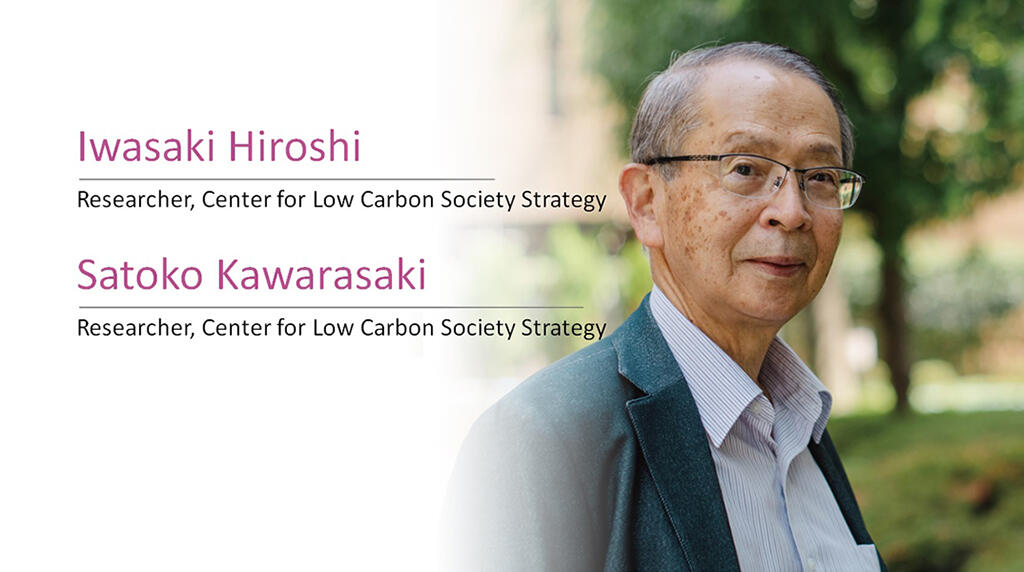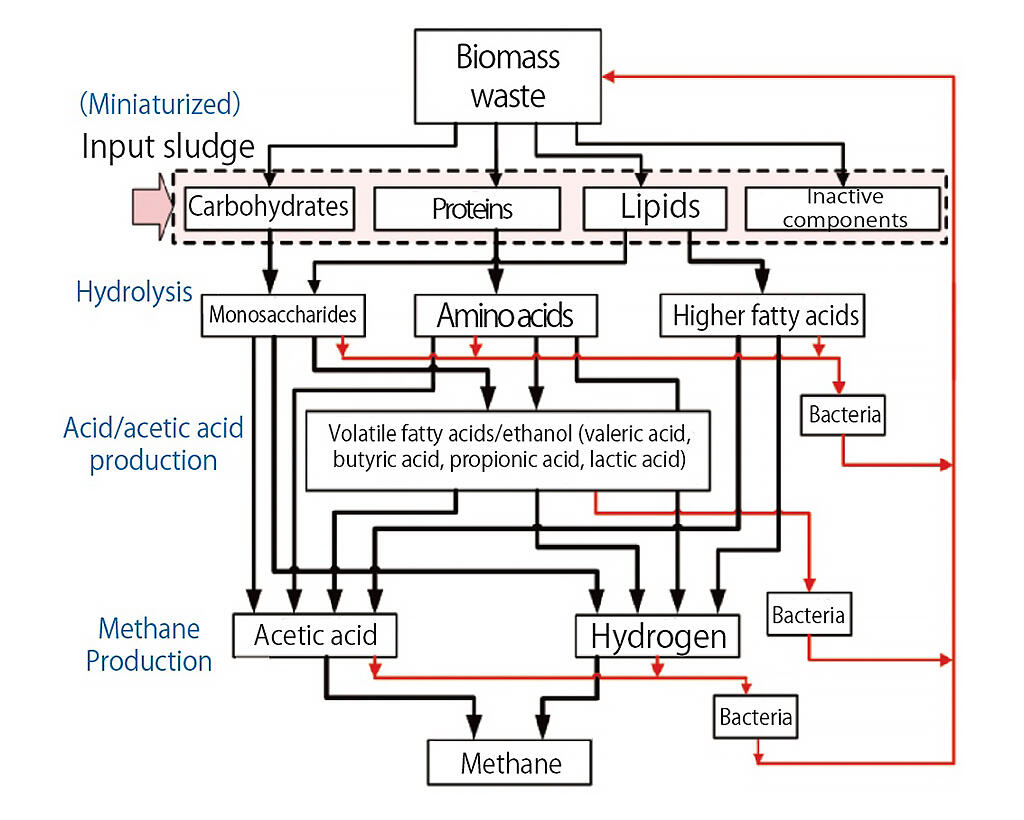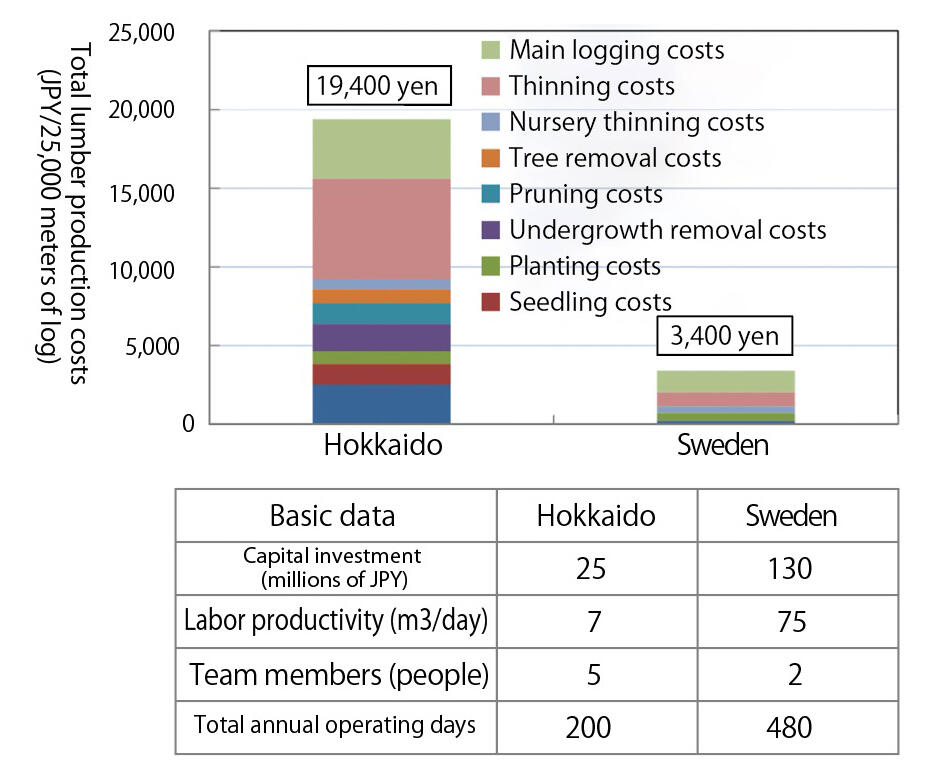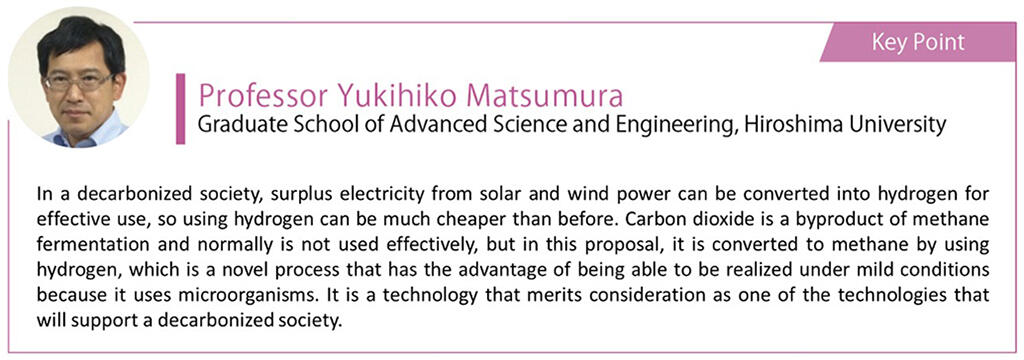
This is the third installment in a series of stories in which Yutaka Minakawa, a young employee of a trading company, reads and analyzes proposals issued by the Center for Low Carbon Society Strategy (LCS). In the previous installment, Tomoko Iwata, a Visiting Researcher at the LCS, told Minakawa about how individuals can contribute to decarbonization. In this installment, Minakawa interviews Hiroshi Iwasaki, a researcher at the LCS who is working on optimizing the methane fermentation of biomass waste, and Satoko Kawarasaki, a researcher at the LCS who is working on reducing the production costs of woody biomass, about decarbonization initiatives using biomass.
Fermentation of Resources Derived from Living Things: A step towards the use of highly valuable methane
Minakawa: Today I'm here to talk about biomass. Compared to renewable energy such as solar, wind, and hydroelectric power, it seems that biomass is relatively unfamiliar to people, so what do you mean when you talk about biomass?
Iwasaki: Breaking down the word, "bio" = "organism" and "mass" = mass or material, so "biomass" refers to all things or materials that are derived from organisms. In that sense, our bodies are also biomass, but, in the context of "resources," biomass includes rice straw, leftover material from palm oil production, leftover material from food production, food waste from homes and stores, human and livestock excrement, and wood, and so on. As you may know, coal and oil are also resources derived from living organisms that lived tens or hundreds of millions of years ago, but these fossil fuels are not included in biomass.
Minakawa: Fossil fuels and biomass seem to be the same in that they emit carbon dioxide (CO2) when burned, so why is only biomass included in renewable energy?
Kawarasaki: The energy from biomass is all originally solar energy that has been fixed by photosynthesis in plants. During combustion biomass energy emits CO2 that was absorbed by photosynthesis, which results in zero net emissions. On the other hand, fossil fuels are CO2 that was fixed by plants over a timespan of hundreds of millions of years, so, in the timespan of human life, the more fossil fuels we burn, the more CO2 will increase in the atmosphere.
Minakawa: Iwasaki, in the biomass field, I understand that you are doing research on methane fermentation, right?
Iwasaki: That's right, biogas is a useful gas resource that is extracted from sewage sludge and livestock manure through the action of microorganisms. Specifically, I am conducting research on extracting methane, which is particularly easy to handle, and which has high value as a resource. Have you ever seen bubbles rising in a marsh or swamp? Those bubbles are the gases that are produced when microorganisms decompose the organic matter that has accumulated at the bottom of the water. The theme of my research is controlling this process in an artificial environment and collecting the methane with high efficiency.
Wild Anaerobic Bacteria at Work.
Exploring Economical Methods
Minakawa: When you talk about microorganisms, do you use any special bacteria?
Iwasaki: Sludge, the raw material, contains a huge variety of organic substances, including carbohydrates and organic acids. There are microbial species that specialize in decomposing each of these substances, and substances that are decomposed by one bacteria are then further decomposed by other bacteria, creating a complex ecosystem network of substances and microorganisms in the sludge. Then, methane is ultimately produced by methanogens (methane-producing bacteria).
Minakawa: Are there any common characteristics among the bacteria that you work with?
Iwasaki: They are anaerobic bacteria, which means that they can live in an oxygen-free environment. All of the bacteria are wild bacteria that originally existed in sludge, and we do not add cultured bacteria as people do when making fermented foods such as alcohol.
Minakawa: Methane is the main component of the natural gas that we commonly use, right? Which one is cheaper?
Iwasaki: Unfortunately, natural gas is currently much cheaper. Therefore, in order to realize efficient methane fermentation, we are searching for the most economical fermentation method by controlling the sludge's concentration, temperature, and pH. Incidentally, a more alkaline pH produces more methane, and a more acidic pH produces more hydrogen (Fig. 1).
Fig. 1: Elementary reactions in methane

Minakawa: Are there any plans to have hydrogen as the main target?
Iwasaki: Hydrogen is certainly very useful for fuel cells and industrial applications, but right now we are focusing on methane production because methane is easier to handle in terms of storage and transportation.
Wood costs six times that of Northern Europe: Challenges in scale, intensity, and efficiency
Minakawa: Next, I would like to ask Kawarasaki about woody biomass. Like Iwasaki, you are also doing research on reducing the costs of biomass resources, but it seems that, even though you are both working with the same biomass, what you are doing is quite different from methane fermentation.
Kawarasaki: Yes, woody biomass is quite different compared to all other energy sources. It is very valuable, not only as energy, but also as a material.
Minakawa: Woody biomass of course has traditionally been used for timber and paper manufacturing, but recently it has also been used as a raw material for plastics and hydrogen, right? However, I feel that there is often negative news about Japan's forestry industry, such as aging workers and neglected forests.
Kawarasaki: A large number of trees were logged during the war, then afterwards there was a period in which forest planting was expanded, and now those trees are ready to be harvested. However, this resource is not being sufficiently utilized. The real issue is cost. The costs of everything from planting the trees to managing the undergrowth removal and thinning, logging, and transportation are high, so they are not price competitive with imported timber. As a result, it is less attractive as a business, and there is a trend that workers and funding cannot be gathered.
Minakawa: Conversely, what countries are strongly competitive in the forestry industry?
Kawarasaki: That's a good question. I compared the log production cost per volume between Hokkaido and Sweden, one of the world's leading forestry industry countries (Fig. 2).
Fig. 2: Cost comparison of each log production process (main logging volume: 150 m3/ha)

Minakawa: Timber from Hokkaido costs about six times as much!? No wonder there's no competition. I have an image that northern Europe has high labor costs, but why is there such a difference?
Kawarasaki: The difference is in business scale and in thorough intensity and high efficiency. Large amounts of capital investment are centered in Sweden, and private forestry contractors efficiently work in 24-hour shifts using huge, high-performance forestry machinery. The machinery operation rooms are comfortable, labor productivity is very high, and the employees are well paid. Companies receive orders from forest owners and are responsible for much of the supply chain, from forest maintenance to logging, transportation, and sale of the timber.
Minakawa: Why does Sweden attract so much capital investment?
Kawarasaki: One of the factors that attracts investment is the high profitability that I mentioned earlier, and the other is the ease of making long-term forecasts. The latter in particular is the result of forest development that is based on long-term planning to promote sustainable forestry. In recent years, planned forestry operations that constantly monitor resource levels have taken root, and resource levels have remained constant.
Minakawa: It seems that sustainability is becoming very attractive for businesses.
Overcoming social constraints and creating sustainable systems
Minakawa: I think that Japan also has sufficient resources, so why can't Japan do something similar?
Kawarasaki: While there are natural constraints such as the many steep slopes in Japan's mountainous forests, the biggest bottleneck is social constraints. About half of the planted forests in Japan are privately owned, and 70% of them are small-scale (less than 50 hectares). There is neither the money nor the forests to support large-scale, intensive forestry operations.
Minakawa: If that is the case, why not somehow raise funds to create a large-scale entity and treat the patchwork of forest ownership as a single entity?
Kawarasaki: That is exactly what we are considering. We want to create an intensive and sustainable forestry system that takes into account and optimizes forest growth, resource distribution, and topography.
Iwasaki: Social constraints are also a bottleneck for biogas. It is difficult to gain price competitiveness without increasing the scale of production, and support from the government and private sector is also necessary. In addition, with methane fermentation it is difficult to obtain methane concentrations that are equivalent to the methane concentrations of city gas, so it cannot be used as-is with existing gas equipment. If there was gas equipment that could be used just with biogas, then the possibility of widespread use would considerably increase.
Minakawa: I think the same is also true of other renewable energy, that the social and economic environments surrounding them are also important, not just the science and technology. In order to protect the "environment," the "environment" is important, and that seems to be connected to my company's business as well! Thank you for your time today.
* This is a fictional narrative based on an interview.
(Text and photos by Tomokazu Fukui)





